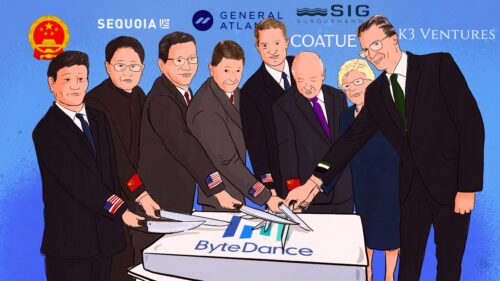China tech’s ‘new normal’: Are the go-go years over for mainland startups?

A “capital winter” has chilled investment in China’s technology sector, and this could have far-reaching implications for the country’s startups, writes Dominic Morgan.
Illustration by Anna Vignet

Until recently, fundraising was a breeze for many entrepreneurs in China. Any startup in a trendy space with a good story had a chance of securing investment.
“You could get $3 million with two people knocking and a smile,” said William Bao Bean, head of Chinaccelerator, a Shanghai-based startup accelerator, in a recent interview.
But the days of easy money appear to be over, at least for now, and this could have big implications for the development of China’s technology sector.
After five years of extraordinary growth, venture capital and private equity investment in China slowed sharply in late 2018, and this “capital winter” has continued into 2019.
Private equity funds put just $6.3 billion into Chinese startups in the first quarter, down from $16.3 billion the previous year, according to data firm Refinitiv.
Firms in China are already feeling the pinch from the slowdown, according to Douglas Corley, CEO of DHB Global, a platform that connects startups with investors in the health sector.
“Many early-stage and growth-stage entrepreneurs are telling me that their batch has already been hit,” Corley says.
China’s tech ecosystem has experienced dry spells before, and there is a chance that the funding floodgates could reopen, especially if China and the United States are somehow able to resolve their disputes on trade and technology.
But there is also a sense that this time is different. Though the trade war has certainly played a role, there are other, longer-term factors making investors more cautious, and this is changing the game for startups.
Taps running dry
Startups are finding it harder to attract funding partly because investors are themselves struggling to raise capital.
There has been a steep drop in the volume of funding being channeled into China-focused tech investment funds since the start of 2018.
The number of venture capital (VC) and private equity (PE) firms closing new funds dropped 59 percent year-on-year in the first quarter, a survey by the Chinese Academy of Science and Technology found.
A major driver of this slowdown is the Sino-U.S. trade war, which has knocked business confidence and triggered a sharp fall in the Chinese stock markets.
This has made life particularly difficult for China’s 2,000 government-controlled “guidance funds,” which play a big role in promoting strategic industries like artificial intelligence and robotics.
These funds, which are mostly run by regional authorities, tend to tap large local companies for funding but are finding this more challenging in the current climate.
“All the listed companies are tightening their belts themselves, and so this has contributed to the difficulties in fundraising,” says Nina Xiang co-founder of China Money Network, a research firm that tracks China’s VC market.
But possibly even more significant, especially for private funds, has been the clampdown on risky financial lending practices launched by Beijing in early 2018.
“The financial regulation of the asset management market has cut off liquidity, so there’s less capital available to the VC market,” Xiang says.
There were clear signs of a slowdown in fundraising even before the trade war escalated last September.
While the first half of 2018 was a record period for VC investment in China, it also saw a 53 percent decline in the amount of capital raised by funds for seed and early-stage investments, a survey by Zero2IPO found.
Investor jitters
Current U.S.-China tensions are also making some investors more hesitant about investing the funds they have already raised.
In many cases, the issue is not that funds lack capital. Financial data provider Preqin estimates that Asia-focused VC funds are sitting on $95 billion that they are waiting to deploy.
But some VCs are becoming reluctant to invest in Chinese startups, especially in high-tech industries that have become politically sensitive.
“U.S. dollar funds are much more cautious compared to past years,” Corley says. “AI health was a major trend, but has slowed down considerably. Many deals were cross-border, and this has been very tightly regulated by CFIUS [the U.S. foreign investment screening body].”
Domestic RMB funds, which account for around 75 percent of VC investment in China, are spooked by the growing hostility toward Chinese tech firms among U.S. regulators.
Investors worry above all that startups in strategic sectors will be blocked from going public on U.S. stock exchanges, which has been the preferred destination for Chinese firms.
“For some high-tech startups, particularly in areas like AI, pursuing a U.S. initial public offering seems almost out of the question,” Xiang says. “This is affecting the kind of exit that investors can pursue.”
After the flood
Other investors, meanwhile, are more concerned about issues within the Chinese startup ecosystem itself.
In a sense, China’s VCs are suffering a comedown from the investment binge they embarked on between 2014 and 2017.
As Kai-Fu Lee, CEO of Sinovation Ventures, points out in his book AI Superpowers, the extraordinary boom in investment was largely driven by the Chinese government’s call for a new era of “mass entrepreneurship and innovation” in 2014.
This move caused a sensation and sparked a flood of private capital to flow from traditional industries, such as property and manufacturing, into hundreds of newly created venture capital funds — both private and government-controlled.
This massive mobilization of resources transformed the global technology landscape. In 2013, China accounted for just 4 percent of global VC investment. By 2018, this had risen to 32 percent, according to consulting firm Bain.
The boom fueled the emergence of many world-class businesses that made even Silicon Valley sit up and take notice — from life services super-app Meituan-Dianping, which went public at a $50 billion valuation last year, to Bytedance, maker of the video app TikTok.
But it also created large bubbles in the market that are now in the process of deflating.
There were so many investors competing to invest in a limited pool of startups that founders enjoyed enormous leverage. And this spread all the way across China’s technology sector, with companies trading at ever-high valuations.
Chinese internet and technology firms involved in merger and acquisition (M&A) deals among private equity firms were trading at 31 times earnings in 2016-2018, 2.4 times the average rate in Asia-Pacific and twice as high as firms in other sectors of the Chinese economy, according to Bain.
There was already a sense that the Chinese market was overpriced and ready for a correction — as many as two-thirds of the private equity investors surveyed by Bain said that they saw a “high or very high” risk of the bubble popping.
The trigger moment came last July when Xiaomi, one of China’s most famous tech brands, dismally failed to achieve its target valuation in its Hong Kong listing.
“Within the [VC] industry, many are now saying that Chinese companies are suffering from ‘revenge of the high valuations,’” says Ying-Ying Lu, co-host of the TechBuzz China podcast (disclosure: part of The China Project’s Sinica Podcast Network).
Crunch point
With the external environment darkening and many funds left with a portfolio of overpriced investments, there has been a fundamental shift in mindset among investors that is already being felt across the tech sector.
“The ‘smart money’ in China has readjusted its expectations about what’s possible, particularly in consumer-facing digital products and services,” says Michael Norris, an analyst at research firm AgencyChina.
The dream-chasers now appear to be looking elsewhere for high-risk, high-reward investments.
In the first quarter, Asia-Pacific startups based outside China raised more funds than their counterparts on the mainland for the first time in five years, according to consultants KPMG.
India and Southeast Asia — with their fast-growing economies, large consumer bases, and relative lack of powerful incumbents — are the most popular destinations.
“[Some companies] are trying to replicate the China model in Southeast Asia, and I think that will continue to be a good area for startups,” Jeremy Choy, head of mergers and acquisitions at private equity firm China Renaissance, told the Financial Times.
VCs focusing on China are trying only to make safe bets, which is making life tough for smaller players.
“We’ve seen a bifurcation in terms of startups’ ability to raise capital,” Xiang says. “The leading firms are continuing to raise hundreds of millions of dollars, but in certain emerging sectors the entry barriers are much higher than a few years ago.”
This is changing the culture among Chinese startups, especially new ventures that are looking for early-stage funding.
“The days of back-of-napkin term sheets appear to be over for now,” Corley says. “Investors are now requiring more metrics of traction and modest burn rates.”
“It’s changing the way startups grow. Instead of a Blitzkrieg mentality — grow at all costs — they need a path to profitability in the next 12 to 18 months.”
For companies that are unable to wean themselves off a cash-burning business model, however, the future looks bleak.
“There will likely be a reset for valuations in the mainland,” Corley says. “Down rounds, death, or M&A will be the norm. VCs have hemorrhaged too much money for too long with no return or pure loss.”
This type of reckoning will likely be most painful in sectors where government-driven hype encouraged high levels of speculative investment, such as artificial intelligence and electric vehicles.
New dawn
The consensus among analysts and investors is that the market correction will continue for at least another year or two. The question is what kind of startup ecosystem emerges from this downturn.
For Rebecca Fannin, author of Tech Titans of China, the “capital winter” could prove to be “a good thing” for the long-term development of the tech sector, as only the most competitive firms will survive.
Though there has been a recent decline in venture investment levels, China remains one of the world’s most attractive markets, and investment support remains. “Good companies will still be able to find funding,” Fannin says.
Many investors share a similar view. “If the level of investment falls, valuations are also likely to decline, but as long as a company itself is healthy and has solid fundamentals, then there is no need to be overly nervous,” Zhou Wei, one of China’s leading venture capitalists, said in a recent interview.
The slowdown could also stimulate healthier competition. The sheer volume of funding available had started to become toxic, with startups competing more on fundraising ability than fundamentals.
“The past 10 years have been the craziest decade for VC investing in China,” Lu says. “Entrepreneurs cared more about how to raise the next round of funding rather than focusing on investing in improving their core technology or business processes.”
But investors now appear to have less appetite for this kind of slash-and-burn growth strategy, especially in consumer-facing markets where valuations have been on the decline.
Previously, the rise of a firm like Luckin Coffee, a coffee delivery outfit that opened 2,000 outlets and went public in just 18 months, would have triggered an investment frenzy, with dozens of copycat coffee startups emerging. But so far, the Beijing-based company has had a relatively clear run.
For Corley, investors are currently unwilling to get involved in another wasteful turf war like the one fought between bike-sharing firms Ofo and Mobike, which led to Ofo collapsing in spectacular fashion in December.
“Ofo has taught investors lessons, but there are still investors seeking the next trend, and that is a tough philosophy to change,” Corley says.
An end to investment frenzies would bring mixed blessings to China, Norris predicts.
Though these wars of attrition have become “more volatile and less conducive to economic value creation” as the tech market has matured, the intense competition that comes from fighting off dozens of nearly identical firms helped sharpen the entrepreneurial skills of a whole generation of Chinese founders.
“Meituan, [ride-hailing giant] Didi Chuxing, and [eductech leader] VIPKid were all built off the back of investment frenzies,” Norris says.
The “capital winter” could harm the competitiveness of China’s tech sector in other ways, too. The decline in funding for early-stage startups is choking the pipeline of potential game-changers and handing even more power to Alibaba and Tencent, which are dominant investors as well as market players.
But for Xiang, the biggest risk of all is that a further deterioration in relations between the U.S. and China will harm China’s attractiveness to investors, forcing the state to step in to make up the shortfall.
“The Chinese government interferes more than government investors elsewhere,” Xiang says. “The more the government plays a role in the VC market, the more cumbersome the whole industry becomes.”





